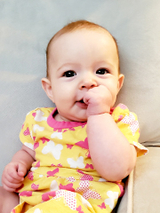Sacrococcygeal Teratoma Surgery: Julia’s Story
Sacrococcygeal Teratoma Surgery: Julia’s Story
Having already given birth to seven children, Jenny knew what to expect at the 20-week anatomy scan. So, when the ultrasound of her eighth child, Julia, was lasting longer than normal, she knew something was wrong. Fortunately, she was referred to CHOP’s Richard D. Wood Jr. Center for Fetal Diagnosis and Treatment, which has one of the greatest experiences in the world with fetal management of sacrococcygeal teratoma.

At Jenny’s 20-week anatomy scan, the obstetrician at the hospital near her home in Allentown, Pa., said she saw a mass at the bottom of the fetus’s spine. A sacrococcygeal teratoma (SCT) is a potentially life-threatening tumor located at the base of the tailbone. SCTs can grow rapidly, so it is critical to go to a center with extensive experience dealing with fetal tumors.
Diagnosing a fetal tumor
Jenny was referred to the Richard D. Wood Jr. Center for Fetal Diagnosis and Treatment (CFDT) at Children’s Hospital of Philadelphia (CHOP). Her first appointment at the CFDT was a thorough, day-long evaluation that included fetal ultrasound, ultra-fast fetal MRI, and fetal echocardiogram. At the end of the day, Jenny and her husband, Derek, sat down with maternal-fetal medicine specialist (MFM), Juliana Sanchez Gebb, MD, a fetal therapy nurse coordinator, and fetal and pediatric surgeon, William Peranteau, MD, to discuss the diagnosis.
The fetus had a large, type 2 SCT, a potentially life-threatening tumor, located at the base of its tailbone. There was a small portion of the tumor growing inside the body and a larger portion growing outside of the body.
Large teratomas that grow into the abdomen can compress the nearby developing organs. They can also have consequences in terms of their blood supply. Tumors that are solid, richly supplied with blood and grow quickly can steal blood away from the developing fetus and placenta and cause heart failure.
The fetus wasn’t in immediate danger of heart failure. The care team collaborated with CHOP’s specialized Fetal Heart Program to follow the impact of the SCT on the fetal heart function through a series of fetal echocardiograms. If it looked like the fetus was going into heart failure (also called fetal hydrops), the team would either deliver the baby at an earlier gestational age and treat the baby outside the womb, or they would perform fetal surgery to remove part of the tumor and reduce the stress on the fetal heart.
Jenny was scared, but she felt comforted by the confidence of the CHOP team.
“SCTs are pretty rare — 1 in 40,000 — but you walk into CHOP and they treat it like there’s nothing strange about it,” says Jenny.
Close monitoring during pregnancy and delivery at CHOP
Jenny returned to the CFDT for follow-up appointments, first monthly, then biweekly and then weekly toward the end of her pregnancy. At each follow-up appointment, the SCT was larger. By 38 weeks’ gestation — the planned time of delivery — the tumor was about the size of a grapefruit. While it’s common for babies with SCTs to require birth by C-section, Jenny hoped to deliver vaginally. Luckily, the tumor was mostly fluid-filled. The care team was able to support and fulfill Jenny’s vision for her delivery while also ensuring mom and baby’s safety by performing a procedure to drain fluid from the tumor to decrease its size prior to induction of labor.
Delivering at CHOP
Julia was born in CHOP’s Garbose Family Special Delivery Unit (SDU). The SDU was created specifically for babies like her, who require surgery and/or intensive care immediately after birth. Despite Jenny’s heightened sense of fear due to the birth defect, she says it was her best delivery experience.
“I can’t say enough about the nurses, the midwife and everyone in the SDU,” she says. “You can tell they have a lot of experience dealing with moms who are scared because they were so calming. The way they handled it, I had nothing to be scared of.”
N/IICU stabilization and surgical removal of the SCT
Julia went into shock immediately after she was born. She was resuscitated with continuous positive airway pressure (CPAP) and admitted to CHOP’s Harriet and Ronald Lassin Newborn/Infant Intensive Care Unit (N/IICU). After two days on CPAP, she was able to breathe room air.
Dr. Peranteau drained the remaining fluid from the SCT and surgically removed the tumor, as well as Julia’s tailbone, to help lower her chances of recurrence. Julia spent a little less than two weeks in the N/IICU and then was moved into the Infant Transitional Care Unit (ITCU) for another week before she was discharged home.
Happy to be the youngest of eight

Now 5 months old, Julia is relishing the attention that comes with being the youngest of eight children, says her mom. She babbles, laughs, and rolls over, and is already showing signs of trying to crawl.
“They are over the moon for her,” Jenny says of Julia’s siblings. “She’s doing really well. She’s a strong little fighter.”
Jenny still keeps in touch with the CFDT social worker and fetal therapy nurse coordinator who helped her family throughout their care journey.
“We had such great supports from CHOP,” she says. “I feel like we made some friends out of the deal.”
Jenny hopes that this story of her family’s experience will be a light for other families going through a similar experience.
“I was so scared to go through what we went through. I knew there was another side of the tunnel, but at the time, I couldn’t see it,” she says. “And now here we are, on the other side of the tunnel. We can look back and be so thankful.”